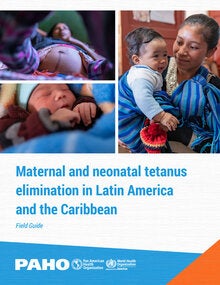Neonatal tetanus (NT), a severe newborn illness from the toxigenic strains of Clostridium tetani, persists in middle- and low-income countries due to non-sterile childbirth practices. Unlike smallpox and polio, tetanus cannot be eradicated: Clostridium tetani spores exist in the environment, and animal reservoirs. However, elimination as a public health issue is achievable through widespread tetanus vaccination, clean deliveries, and proper umbilical cord care. The goal of eliminating maternal and neonatal tetanus (MNT) as a public health problem is considered met when all municipalities in a country have an annual incidence rate of NT of less than 1 case per 1000 live births. The Region of the Americas achieved the maternal and neonatal tetanus elimination (MNTE) target in 2017 when elimination was validated in the Republic of Haiti. Yet maintaining this progress requires continued efforts. High vaccination coverage, booster doses in countries lacking them, hygienic practices, and strong maternal and child health services are key. The Pan American Health Organization’s (PAHO) integrated maternal and neonatal immunization platform further strengthens this fight against early childhood diseases. One of the goals of PAHO’s Regional Immunization Action Plan (RIAP) is to establish and strengthen maternal and childhood vaccination in the context of improving health services for the effective administration of vaccines. This field guide places specific emphasis on the objective of sustaining the elimination of maternal and neonatal tetanus in the regions of Latin America and the Caribbean. The primary audience for this guide consists of managers of the following programs: health ministry immunization, epidemiological surveillance, and maternal and child health. |

